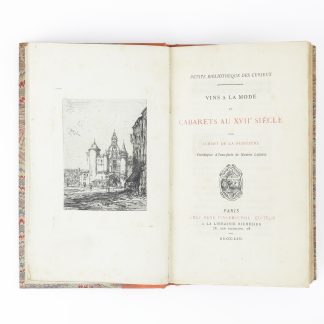Description
Le Caveau Moderne or Le Rocher de Cancalle, table songs composed of the best songs from the old Caveau, the Dîner de Vaudeville, the Société épicurienne, the Caveau Moderne etc...
A rare complete collection in uniform bindings of this Parisian drinking, singing and literary journal.
Founded in Paris in 1729 by Pierre Gallet, The Caveau company(abbreviated to le Caveau), which met twice a month in the lower room of a cabaret on rue de Buci and included such illustrious figures as Piron and the Comte de Caylus. It disappeared after ten years of existence, but reappeared in 1759 thanks to the dinners given every Wednesday by the farmer-general Jean-Baptiste Pelletier. Former members of the Cellar new guests, Jean-François Marmontel, Jean Baptiste Antoine Suard, Boissy d'Anglas and Laujon, but the society disappeared during the Revolution. After a six-year hiatus, Vaudeville dinners continued the tradition, bringing into the circle successful authors who, like the founders, paid for their meals with a song for each dinner. Despite the reluctance of the authors, these songs were published monthly by subscription from Vendémiaire an V (1796) until the society ceased to exist on 2 Nivôse an X (23 December 1801).
In 1806, Armand Gouffé and the poet, songwriter and bookseller Pierre Capelle reorganised thehe Vaudeville Dinners, under the name : Caveau Moderne or the Rocher de Cancalenamed after the gastronomic establishment where the musical feasts are held, on the 20th of each month. Rock of Cancaleopened in 1804 and located on rue Montorgueil, at the corner of rue Mandar. Le Caveau moderne was chaired by Pierre Laujon, then by Désaugiers , who composed most of the songs for the society's dinners. The bookseller-publisher Capelle was responsible for collecting the works of the society, publishing a booklet every month and a volume every year; the receipts thus made it possible to finance the expenses of the members' table. The society had a number of prominent members, including Gouffé, Grimod de La Reynière, the founder of theAlmanach des Gourmands, Jouy and a number of academics, Ségur aîné, Regnaud de Saint-Jean-d'Angély and Pierre Laujon.
In 1813, Béranger, presented by Désaugiers, became a member of the Modern cellar and composed a reception song: The Academy and the Caveauin which he praises the merits of Modern cellar compared toAcadémie française. Le Caveau moderne contributed to the author's popularity by publishing his most famous songs from 1813 to 1816: Gaudriole, la Bacchante, Madame Grégoire, Ma Grande-mère, Frétillon, la Grande orgie, Voyage au pays de Cocagne, Roger-Bontemps, les Infidélités de Lisette, Mon curé, la Descente aux enfers...
During the Restoration, the opportunism of certain members led to some dissension, which was probably the reason for the society's demise in 1817.
Elegant collection soberly produced at the time in green half vellum.
Songs by Maitre Adam, Anson, Antignac, Armand-Charlemagne, Armand-Gouffé, Barré, Baudé, Bérangé, Bernard, Belle, Bernard-Valville, Brazier, Bernis, Bonneval, Brazier, Capelle, Chavet, Charrin, Charles de Sartrouville, Charveral, Collé, Coupart, Crébillon, Coupé, C.LC.., Delorme, Demautort, Désaugiers, Deschamps, Derougemont, Derrien, Desaugier, Desfontaines, Desprez, Despéraux, Dieulafoy D.J., Dorat, Ducray-Duminil, Dupaty, Fabien-Pillet, Favart, Francis, Fulgence, Gentil, Grille, Gratton, Haguenier, Imbert, Jacquelin, Jouy, Lagarde, Labitte, Labro de Montagnac, Lamotte, Lattaignant, Laujon, Lerat, Lonchamps, Lupin, Martin Crecy, Massot, Mayeur, Mellinet, Mentelle, Manard de Rochecave, Milevoye, Morel, Moreau, Négrel, Nivernois, Orléans, Ourry, Panard, Pantin, Ph. de la Madeleine, Pils, Piron, Pitot, Pitt, Ponteau, Prévost-d'Iray, Raboteau, Radet, Reynard, Richard de Lucy, Salverte Saurin, Ségur aîné, Servière, Talairat, Tezénas, Théaulon, Voisenon.
- First volume 1807, 304 pp. Frontispiece by Fontaine engraved by Mariage:" To see good choruses blossom, / Let's drink again.". Two calligrams, in the shape of a glass and a bottle, by Capelle (page 240-241).
- Second volume 1808, 342 pp. Frontispiece by Fontaine engraved by Mariage:"Deserting the court of Cythera, / Cupid is harvested.".
- Third volume 1809, 372 pp. Frontispiece drawn and engraved by Tourcaty:"The King drinks!...".
- Fourth volume 1810, 376 pp. Frontispiece drawn and engraved by Tourcaty: " Let's get drunk on the Bottle […]"
- Fifth volume 1811, 376 pp. Frontispiece drawn and engraved by Tourcaty: " He liked it, he drank well, he was a true epicurean."
- Sixth Volume 1812, 340 pp. Frontispiece drawn and engraved by Tourcaty: " English and the President"
- Seventh Volume 1813, 320 pp. Frontispiece drawn and engraved by Tourcaty portrait of A.P.A DE PIIS
- Eighth Volume 1814, 362 pp. Frontispiece by Etienne Jourdan: "Cadet Buteux at Boulevard du Temple"
- Ninth year of the collection [ninth volume] 1815, 282 pp. Frontispiece by Serouge: " A heavy gourmet […]"
- Tenth year of the collection [tenth volume] 1816, 284 pp. Frontispiece by Aze: " Is my poor skirt wet enough? [...]", First publication of Béranger's chansons libres.
- Eleventh year of the collection [eleventh and last volume] 1817, 282 pp. Frontispiece by Beregrel engraved by Aze: " See you in simple hunting clothes […]"
5 identically bound volumes of the New Cellar, following the Caveau Moderne & l'Enfant Lyrique du Carnaval, a selection of the best songs, most of them unpublished, by members of the Caveau moderne and the Soupers de Monus, published by Mr Oury, for the years 1819, 1821, 1822, 1824 and 1825.
Bound in contemporary style. Green half vellum, muted smooth spine. Some rubbing, one cap damaged in the attached set.


